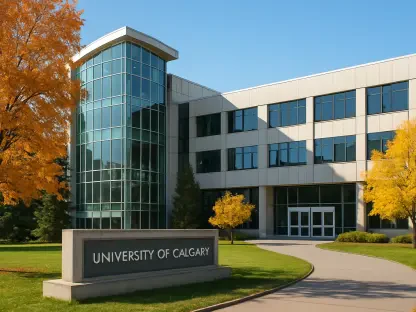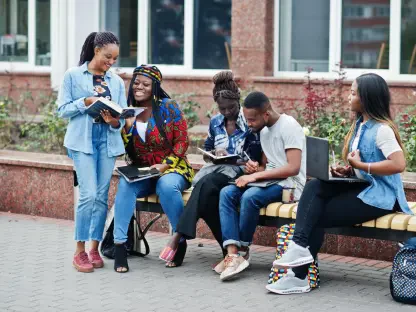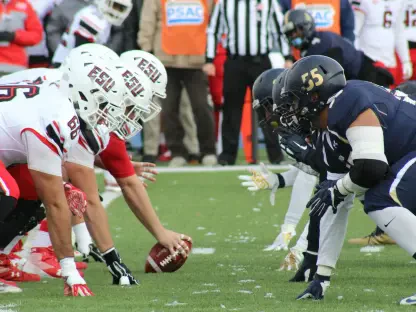Navigating the path to a college degree is a monumental challenge for many, but for first-generation students—those whose parents did not earn a bachelor’s degree—the journey often comes with unique and formidable obstacles that can derail even the most determined individuals. Recent data from a comprehensive Common App report, analyzing the academic trajectories of over 785,000 applicants, reveals a troubling reality: while these students enroll in higher education at rates comparable to their continuing-generation peers, their likelihood of crossing the graduation finish line lags significantly behind. This disparity isn’t just a statistic; it represents personal dreams deferred, financial burdens accrued, and systemic inequities that demand attention. Delving into the reasons behind these gaps, from initial enrollment hurdles to hidden barriers in college culture, provides critical insight into what holds first-generation students back and how targeted interventions might pave a smoother road to success.
Early Challenges in the College Journey
The road to higher education often begins with promise for first-generation students, as enrollment rates show near parity with their peers, with over 90% of Common App applicants securing a spot in college within six years of applying. However, subtle yet impactful differences surface early on. A higher proportion of first-generation students tend to delay their start, with 17% postponing enrollment compared to 14% of continuing-generation students, often due to financial constraints or family responsibilities. Additionally, they are more likely to begin at two-year colleges, with 12% choosing this path versus just 4% of their peers, possibly seeking more affordable options or needing remedial coursework. These initial choices, while practical, can set a precedent for longer and more complex academic journeys, potentially contributing to later challenges in degree completion. While strong high school performance can mitigate some of these early barriers, the foundation for future struggles is often laid in these critical first steps.
Beyond the decision of when and where to enroll, first-generation students frequently grapple with a lack of familial guidance on navigating the higher education landscape, which can exacerbate early missteps. Unlike their continuing-generation counterparts, who may benefit from parents familiar with college processes like financial aid applications or course selection, first-generation students often rely on trial and error or limited institutional support. This gap in navigational knowledge can lead to delays in securing funding or choosing programs that align with long-term goals, creating unnecessary stress and time burdens. Financial pressures also play a significant role, as many must balance work with academics, further stretching their resources thin. These early hurdles, though seemingly small, accumulate over time, often resulting in a slower start or detours that make the path to graduation more arduous. Addressing these initial disparities with targeted outreach and support could help level the playing field from the outset.
Graduation Gaps and Persistent Disparities
When it comes to earning a college degree, the divide between first-generation students and their peers becomes starkly evident, painting a picture of systemic inequity that defies simple solutions. Data highlights that only about 50% of first-generation students graduate within four years, compared to 68% of continuing-generation students, a gap that remains significant even after six years, with 69% versus 86% completing their degrees. This disparity isn’t confined to any single subgroup; it persists among those with strong academic records or higher income levels, suggesting that the root causes extend beyond traditional barriers like financial hardship or inadequate preparation. Such consistent gaps point to deeper, structural issues within higher education that disproportionately affect first-generation students, leaving many unable to achieve the culmination of their hard work despite years of effort. Understanding these numbers is crucial to identifying where interventions can make the most impact.
Digging deeper into these graduation disparities reveals that the challenges are multifaceted, often tied to a lack of sustained support throughout the college experience. First-generation students may face difficulties in adapting to academic rigor without prior exposure to college-level expectations, leading to lower persistence rates. Even those who enter with high test scores or GPAs are twice as likely to leave without a degree, with 14% dropping out compared to just 6% of their peers. This suggests that academic readiness alone isn’t enough to ensure success; other factors, such as feeling out of place in campus environments or lacking mentors who understand their unique needs, contribute to higher attrition. The cumulative effect of these challenges often results in extended timelines for degree completion or, worse, abandonment of the goal altogether. Bridging this gap requires more than just access to education—it demands ongoing resources tailored to help these students navigate every stage of their academic journey.
Institutional Impact on Student Outcomes
The type of college a student attends plays a pivotal role in shaping their likelihood of graduating, yet it doesn’t fully account for the persistent gaps faced by first-generation students. Even when enrolled at the same institutions, these students are 10 percentage points less likely to earn a degree within six years compared to their continuing-generation peers. Higher per-student expenditures at colleges correlate with improved outcomes for all, but disparities remain pronounced, especially at under-resourced schools. For instance, at institutions spending at least $20,000 per student, 84% of first-generation students graduate within six years, compared to 94% of their peers. At colleges with lower budgets, the gap widens further, highlighting how resource constraints disproportionately hinder those already facing systemic barriers. While well-funded environments offer a boost, they clearly fall short of eliminating the unique challenges these students encounter.
Moreover, the quality and availability of institutional support services often determine whether first-generation students can overcome the obstacles in their path. Colleges with robust advising, tutoring, and financial aid programs tend to see better retention rates, yet many first-generation students attend schools where such resources are stretched thin or poorly tailored to their needs. The absence of dedicated programs that address cultural adjustment or provide mentorship from faculty or peers who share similar backgrounds can leave these students feeling isolated and unsupported. Additionally, underfunded institutions may lack the capacity to offer flexible scheduling or emergency grants, which are critical for students juggling work and family obligations alongside academics. Enhancing institutional capacity through increased funding and specialized initiatives could create environments where first-generation students are not just enrolled but empowered to thrive and complete their degrees.
Unseen Obstacles in Higher Education
Beyond the more obvious barriers of finances and academic preparation, first-generation students often encounter less tangible but equally formidable challenges that impede their progress toward graduation. Even among those with strong high school records or stable financial situations, dropout rates remain alarmingly high, with 24% of higher-income first-generation students leaving without a degree within six years, compared to just 12% of their peers. Experts attribute much of this to the “hidden curriculum”—the unspoken rules and norms of college life, such as knowing how to approach professors or build professional networks. Without family members who have navigated this terrain, these students often miss out on critical insider knowledge, leaving them at a disadvantage regardless of their credentials or resources. This informational deficit creates a persistent barrier that traditional support systems frequently fail to address.
Compounding this issue is the cultural disconnect many first-generation students experience on campus, which can erode their sense of belonging and confidence over time. Campuses often reflect the values and experiences of continuing-generation students, leaving those unfamiliar with academic culture feeling like outsiders. This can manifest in hesitancy to seek help, engage in extracurriculars, or access resources like career services, all of which are vital for long-term success. Additionally, the psychological toll of being the first in a family to pursue higher education—carrying the weight of expectations while facing unique pressures—can lead to burnout or self-doubt. Addressing these unseen obstacles requires institutions to foster inclusive environments and provide explicit guidance on navigating the academic and social aspects of college, ensuring that first-generation students aren’t left to decipher the system on their own. Only through such intentional efforts can the deeper roots of their struggles be tackled.
The Heavy Cost of Unfinished Degrees
For first-generation students who invest years in pursuit of a college degree only to leave without one, the consequences are both profound and far-reaching, affecting their personal and financial stability. Nearly one-third of those who drop out have been enrolled for at least four years, meaning they’ve often accumulated significant student debt and sacrificed time that could have been spent building a career or gaining other skills. This non-completion represents not just a loss of academic progress but a heavy burden of loans without the earning potential a degree typically provides. The emotional impact is equally significant, as many carry the weight of unfulfilled family expectations or personal aspirations, compounding the sense of setback. Highlighting this issue underscores the urgency of preventing attrition among these students, whose investment in education comes at a high cost when left incomplete.
Furthermore, the ripple effects of not graduating extend beyond the individual to impact families and communities that often rely on the success of first-generation students as a pathway to upward mobility. Without a degree, these students may struggle to access higher-paying jobs, perpetuating cycles of economic disadvantage despite their efforts to break free. The time spent in college also means delayed entry into the workforce, potentially limiting early career experience and savings. Institutions and policymakers must recognize that each dropout represents a missed opportunity not only for the student but for society as a whole, as diverse graduates bring unique perspectives to the professional world. Developing safety nets, such as emergency financial aid or re-entry programs for those who pause their studies, could help mitigate these losses, ensuring that the substantial resources poured into higher education yield tangible returns for those who need them most.
Building Bridges to Success
Looking back, the journey of first-generation students through higher education reveals a landscape marked by both promise and persistent challenges, where enrollment rates match those of peers, yet graduation remains an elusive goal for many. The stark gaps in completion, the weight of unseen cultural barriers, and the personal toll of unfinished degrees paint a picture of a system that, despite good intentions, often fails to meet the unique needs of these students. Institutional shortcomings and informational deficits stand out as key culprits, with even well-prepared or financially secure students falling through the cracks due to a lack of tailored guidance. Reflecting on these struggles, it becomes evident that past efforts, while valuable, need to evolve to address the deeper systemic issues at play.
Moving forward, the focus must shift to actionable solutions that can transform these challenges into opportunities for growth and equity in higher education. Colleges should prioritize investments in mentorship programs and academic advising specifically designed for first-generation students, ensuring they receive guidance at every critical juncture. Increased funding for institutions serving high numbers of these students could bolster resources like tutoring and emergency grants, directly addressing barriers to persistence. Additionally, fostering campus cultures that celebrate diversity and explicitly teach the “hidden curriculum” through workshops or peer networks could help dismantle feelings of isolation. By committing to these strategic interventions, higher education can pave the way for a future where first-generation students not only enroll but thrive, turning their aspirations into lasting achievements.









